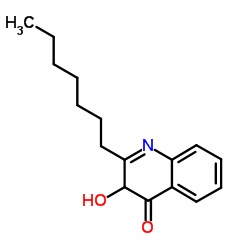Differential immune modulatory activity of Pseudomonas aeruginosa quorum-sensing signal molecules.
Doreen S W Hooi, Barrie W Bycroft, Siri Ram Chhabra, Paul Williams, David I Pritchard
Index: Infect. Immun. 72(11) , 6463-6470, (2004)
Full Text: HTML
Abstract
Pseudomonas aeruginosa releases a spectrum of well-regulated virulence factors, controlled by intercellular communication (quorum sensing) and mediated through the production of small diffusible quorum-sensing signal molecules (QSSM). We hypothesize that QSSM may in fact serve a dual purpose, also allowing bacterial colonization via their intrinsic immune-modulatory capacity. One class of signal molecule, the N-acylhomoserine lactones, has pleiotropic effects on eukaryotic cells, particularly those involved in host immunity. In the present study, we have determined the comparative effects of two chemically distinct and endobronchially detectable QSSM, N-(3-oxododecanoyl)-L-homoserine lactone (3-oxo-C12-HSL) and 2-heptyl-3-hydroxy-4 (1H)-quinolone or the Pseudomonas quinolone signal (PQS), on human leukocytes exposed to a series of stimuli designed to detect differential immunological activity in vitro. 3-Oxo-C12-HSL and PQS displayed differential effects on the release of interleukin-2 (IL-2) when human T cells were activated via the T-cell receptor and CD28 (a costimulatory molecule). 3-Oxo-C12-HSL inhibited cell proliferation and IL-2 release; PQS inhibited cell proliferation without affecting IL-2 release. Both molecules inhibited cell proliferation and the release of IL-2 following mitogen stimulation. Furthermore, in the presence of Escherichia coli lipopolysaccharide, 3-oxo-C12-HSL inhibited tumor necrosis factor alpha release from human monocytes, as reported previously (K. Tateda et al., Infect. Immun. 64:37-43, 1996), whereas PQS did not inhibit in this assay. These data highlight the presence of two differentially active immune modulatory QSSM from P. aeruginosa, which are detectable endobronchially and may be active at the host/pathogen interface during infection with P. aeruginosa, should the bronchial airway lymphoid tissues prove to be accessible to QSSM.
Related Compounds
| Structure | Name/CAS No. | Molecular Formula | Articles |
|---|---|---|---|
 |
2-Heptyl-3-hydroxy-4(1H)-quinolinone
CAS:108985-27-9 |
C16H21NO2 |
|
Quinolone signaling in the cell-to-cell communication system...
1999-09-28 [Proc. Natl. Acad. Sci. U. S. A. 20th ed., 96 , 11229-11234, (1999)] |
|
3-indolylacetonitrile decreases Escherichia coli O157:H7 bio...
2011-01-01 [Environ. Microbiol. 13 , 62-73, (2011)] |
|
The Pseudomonas aeruginosa 4-quinolone signal molecules HHQ ...
2007-01-01 [Chem. Biol. 14 , 87-96, (2007)] |
|
Indole and 7-hydroxyindole diminish Pseudomonas aeruginosa v...
2009-01-01 [Microb. Biotechnol. 2 , 75-90, (2009)] |
|
7-fluoroindole as an antivirulence compound against Pseudomo...
2012-04-01 [FEMS Microbiol. Lett. 329 , 36-44, (2012)] |